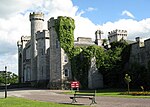Church of St Nefydd and St Mary, Llannefydd
Churches completed in the 1500sGrade I listed churches in Conwy County BoroughHarv and Sfn no-target errors

The Church of St Nefydd and St Mary is an active parish church in the village of Llannefydd, Conwy County Borough, Wales. The village lies 5m south-east of Abergele. Cadw records that the present church dates from c.1550, although it certainly had earlier origins. It was restored in 1859 and again in 1908–1909 by Henry Harold Hughes. The church is designated by Cadw as a Grade I listed building.
Excerpt from the Wikipedia article Church of St Nefydd and St Mary, Llannefydd (License: CC BY-SA 3.0, Authors, Images).Church of St Nefydd and St Mary, Llannefydd
Geographical coordinates (GPS) Address Website External links Nearby Places Show on map
Geographical coordinates (GPS)
| Latitude | Longitude |
|---|---|
| N 53.2227 ° | E -3.5261 ° |
Address
Eglwys Sant Nefydd a Santes Fair
LL16 5EQ , Llannefydd
Wales, United Kingdom
Open on Google Maps









